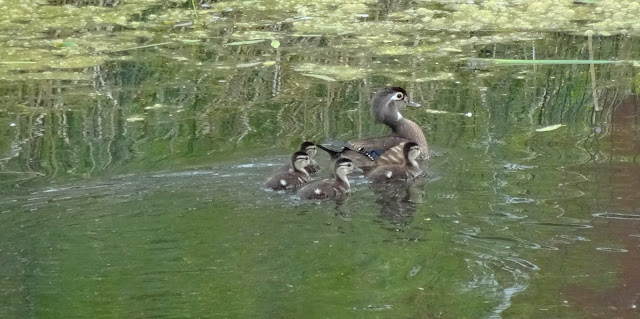The logs are favorite perches for all the creatures in or near the pond - - turtles, ducks, herons, frogs, song birds. The Green Heron Butorides virescens finds it a choice place to preen his feathers while staying close to his hunting area, in case a meal appears nearby.
7/30/2022
7/27/2022
tiny toad
On a patch of gravel a toad, the size of a quarter coin, was hunting for breakfast among the spider webs.
7/23/2022
young blackbird showing epaulets
This young male Red-winged Blackbird was begging his mom to give him food from the seed feeder. I can tell he is a male because he's already starting to get his bright colored 'epaulets' on his shoulders. She has been putting food in his mouth whenever he gapes since he hatched out of his egg. But now that she is hoping he will find his own food!
7/22/2022
vervain
Blue Vervain is blooming profusely in the wetland surrounding the pond. Verbena hastata is also called Swamp Verbena, Blue Verbena, Simpler's Joy; it is a perennial herbaceous plant that blooms every summer. The stiff erect square stems remain standing all winter, providing seeds to the birds in cold snowy months. In the growing season the plant has opposite, simple leaves which have double-serrate margins.
The family name for genus Verbena is Latin for "sacred plant" because it has been used for hundreds of years in various health remedies. The Latin specific epithet hastata means "spear-shaped" and describes the leaves of this plant.
The family Verbenaceae includes herbs, shrubs, and trees; among them, teak trees -- highly prized for its furniture wood.
7/16/2022
turtle chases ducks off favorite rock
Mallard was sunning her ducklings on the favorite rock in the pond. Turtle appeared a few feet away, nosing his way toward the rock, also his favorite. When turtle got to the rock, ducklings jumped off.
7/15/2022
monardas - bee balm - bergamot
Wild Bergamot Monarda fistulosa starting blooming last week all around the pond and in the meadows near here. (left)
The Scarlet Beebalm Monarda didyma started blooming a few weeks ago. (below)
Both plants are in the mint family.
7/10/2022
green frog looks like . . .
. . . like a rubber toy in rocks near the pond. But it sounds exactly like a frog!
The Green Frog is widely present in the eastern half of Minnesota.
Typically greenish-brown on top, and males have yellow throats.
7/08/2022
7/07/2022
culver's root
Culver's Root Veronicastrum virginicum is found growing in wetlands and wet prairies.
The individual flowers are comprised of four fused petals up to a half an inch long. A main spike at the top of the plant is surrounded by several other spikes of flowers. The flowers bloom from the bottom of the spike up. Culver's Root is not bothered much by leaf-chewing insects or mammalian herbivores. The seeds are too tiny to be of much interest to birds. However, many varieties of insects visit the flowers to collect pollen or drink nectar.
(above left) Culver's Root just before it blooms.
(above right) A Black Wasp drinks nectar from the flowers while hunting for prey items; their bodies are covered in fine hairs that also collect pollen.
(below) A Bumble Bee with bulging pollen pockets stops for just a few more from this blooming Culvers Root.
7/05/2022
7/04/2022
7/03/2022
mallard families
Female Mallard came out of the grasses with her 3 young ducks (upper right). Then, another Mallard appeared with her 8 younger ducklings. They were all intent on eating duckweed and other aquatic plants growing in the pond.
Subscribe to:
Posts (Atom)
















